Cellometer Auto T4 Bright Field Cell Counter
Automated cell counter for trypan blue viability for cell lines
Why Auto T4?

Introduction to the Cellometer Auto T4 Bright Field Cell Counter
Cell Counting Made Simple
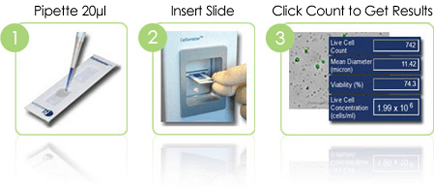
Simple, Automated Cell Counting in 30 Seconds
The Auto T4 utilizes bright field imaging and pattern-recognition software to quickly and accurately identify and count individual cells. Cell count, concentration, diameter, and % viability are automatically calculated and reported.
The Auto T4 Allows Hemacytometer Users to:
- Increase throughput
- Improve consistency
- Ensure all data is correctly captured
- Count difficult cells (clumpy, irregular-shaped)
- Eliminate judgment errors, miscounts, and user-to-user variability
One-step Concentration & Viability
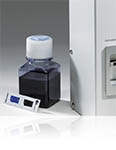
The Auto T4 simultaneously calculates cell concentration and % viability for cultured cells stained with trypan blue.
Trypan blue viability is a dye exclusion method that utilizes membrane integrity to identify dead cells. The dye is unable to penetrate healthy cells, so they remain unstained. Dead cells have a compromised cell membrane that is permeable to the trypan blue dye. Dead cells are stained blue and display as dark cells in the Cellometer software with bright field imaging.
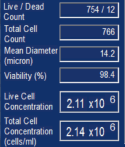 Within 30 seconds, the Auto T4 instrument reports:
Within 30 seconds, the Auto T4 instrument reports:
- Live, dead, and total cell count
- Live and total cell concentration
- Mean Cell Diameter
- % Viability
Counted bright field Image
 Live cells = green circle
Live cells = green circle Dead (stained) cells = red circle
Analyze >99% of Cultured Mammalian Cells, including NCI-60 and clumpy MCF-7 cells
NCI-60 is a group of 59 human cancer cell lines (originally 60) developed by the National Cancer Institute for screening purposes. Isolated from various tissues (bone marrow, lung, ovary, brain, skin, breast, colon, kidney, prostate), the cell lines are used extensively to screen experimental cancer drug compounds and study tumor development.

Clumpy Cells
The MCF-7 breast cancer cell line can be very clumpy. The Cellometer pattern-recognition software identifies and counts individual cells within these cell clumps for accurate analysis (shown at left).
Irregular-shaped Cells
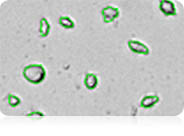
The Cellometer cell roundness setting can be adjusted for recognition and counting of irregular-shaped cells, such as RD cells and activated T-cells.
- 57% of the NCI-60 cell lines are clumpy, contain debris, or display large variations in cell shape or size.
- All 59 NCI-60 cell lines have been successfully validated on the Cellometer Auto T4 Cell Counter.
Cell Size Analysis & Size-based Counting
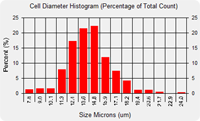
The Auto T4 Cell Counter Automatically generates a cell size histogram based on cell diameter.
Because Cellometer generates individual cell size measurements, multiple samples can be overlaid on one histogram enabling analysis of the change in cell diameter over time.
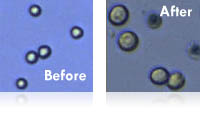
For experiments involving SF9 or SF21 cells, saved images can be viewed and re-counted to analyze changes in morphology over time.
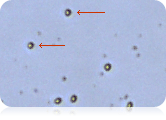
The minimum and maximum cell diameter settings can be optimized to count specific cells in a sample.
This example demonstrates counting of mature dendritic cells cultured from PBMCs based on cell diameter.
Cell Images for Data Verification
No two cells are the same. With the Auto T4 Cell Counter, cell morphology can be immediately viewed on-screen.
Counted cells are indicated on-screen for further verification that cells in the sample are being imaged and analyzed properly.
Users can confirm that:
- Cells are counted correctly, based on size and shape
- Debris is excluded
- Cells within clumps are being counted individually
- Cell images can be archived and exported for use in publications and presentations.
- Saved images can be re-counted using default or user-optimized analysis settings.
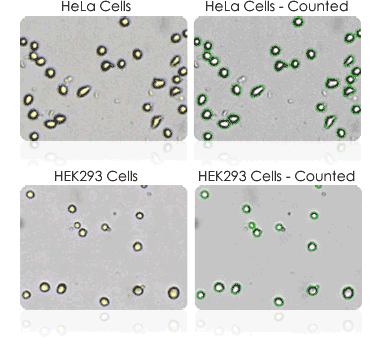
Exclusion of Debris
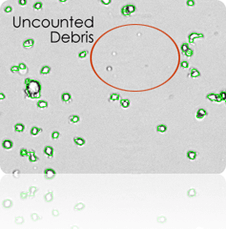
Because Cellometer recognizes cells based on size, brightness, and morphology, cellular debris is easily and accurately excluded from counting results.
- Cell size parameters can be modified to optimize exclusion of debris from results and enhance the accuracy of counting for a wide range of cell sizes.
- The counted image can be viewed to verify exclusion of debris from results.
10x Faster and More Precise than Manual Counting
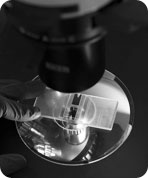
Counting 1 x 106 cells takes approximately 5 minutes with a manual hemacytometer. Counting live and dead cells sometimes takes twice as long. The Cellometer Auto T4 Cell Counter calculates cell count and concentration for live and dead cells and % viability in just 30 seconds.
Improve Data Accuracy & Consistency
- Eliminate Wash Steps
- Eliminate Judgment Errors
- Eliminate Recording & Calculation Errors
- Reduce Counting Time … Run More Experiments
The Cellometer %CV (Coefficient of Variation), including sample preparation, was well under 5% for most cell lines tested. The CVs for manual counts ranged from 7% to 20%. Automated cell counters remove inter-operator variability and subjectivity from cell counts to generate more precise data.

Cellometer Auto T4 |
Hemacytometer |
|||||
Concentration |
n |
CV |
Concentration |
CV |
n |
|
Jurkat |
1.17 x 106 |
4 |
2.27% |
1.11 x 106 |
8.04% |
3 |
YAC-1 |
1.36 x 106 |
4 |
3.17% |
1.41 x 106 |
11.89% |
3 |
K562 |
6.36 x 105 |
4 |
8.29% |
5.58 x 105 |
9.66% |
3 |
H460 |
1.32 x 106 |
4 |
5.57% |
1.16 x 106 |
20.65% |
3 |
SW620 |
3.81 x 105 |
4 |
2.79% |
3.70 x 105 |
19.49% |
3 |
Hut 102 |
9.18 x 105 |
4 |
0.39% |
7.68 x 105 |
10.60% |
3 |
Counting Chambers — No Washing or Contamination
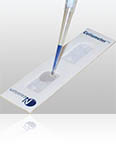
Cellometer Disposable Counting Chambers consist of two independent enclosed chambers with a precisely controlled height. Cell suspension of 20 microliters is loaded into the chamber using a standard single channel pipette. The chamber is inserted into the Cellometer cell counter and the cells are imaged. This simple sample loading and analysis method is ideal for fragile cells.
The disposable Cellometer Cell Counting Chambers offer several key advantages:
- Time savings — no washing
- No risk of cross-contamination
- Reduced biohazard risk to users
- Controlled sample volume
- Large-depth chambers for large cells
- Most affordable automated counting consumables
Easily Print & Save Data and Cell Images

Easily Export to Excel for additional data formatting or sharing. Images and data tables can be pasted into PowerPoint presentations or submitted for publication.
Easily Save data and images to a network or local computer.

Print directly from the software screen. The standard printout displays live, dead, and total cell count and concentration, % viability, and cell images.
Dedicated On-line and On-site Applications Support
Experienced Nexcelom Technical Support Specialists are available from 9am to 5pm EST for phone and on-line support and can assist with:
- Creation of new cell types
- Optimization of counting parameters
- Troubleshooting
- Training of new users
- Installation of a new Auto T4 Cell Counter
The help button at the bottom right of the Cellometer Auto T4 software screen gives users instant access to:
- Software features and instructions
- On-line tutorials and training videos
- Submission of a Support Ticket
Clicking "Submit a Support Ticket" launches a convenient on-line form that is submitted directly to Nexcelom Technical Support
- T4 instrument information fields are automatically populated
- Images are easily attached for troubleshooting and applications support
- A Nexcelom Specialist can assume remote control of the Auto T4 Cell Counter for troubleshooting and training
Cellometer Auto T4 Accessories
IQ / OQ Validation Package
Installation Qualification (IQ) and Operational Qualification (OQ) package for the Auto T4 Cell Counter
| Catalog # | Description | Size | Unit |
|---|---|---|---|
| Cellometer Auto T4-IQOQ | Counting chambers, reference bead solution, and validation protocol for the Cellometer Auto T4 | 100 counts | 1 Set |
On-Site Service, Maintenance, and Instrument Warranties
Trained Nexcelom Applications Specialists are available for on-site preventative maintenance, IQ validation, and OQ validation.
| Service | Description |
|---|---|
| Preventative Maintenance | Available for all Cellometer Systems Please inquire for scheduling and pricing. |
| IQ Validation* | Available for Auto T4 and Vision Systems Please inquire for scheduling and pricing. |
| OQ Validation* | Available for Auto T4 and Vision Systems Please inquire for scheduling and pricing. |
| Extended Warranty | Available for all Cellometer Systems currently under a valid warranty. Please inquire for pricing. |